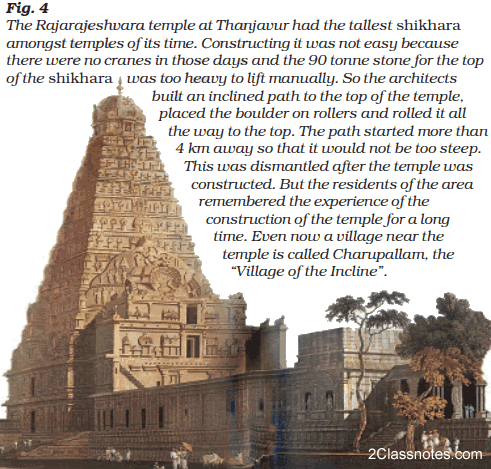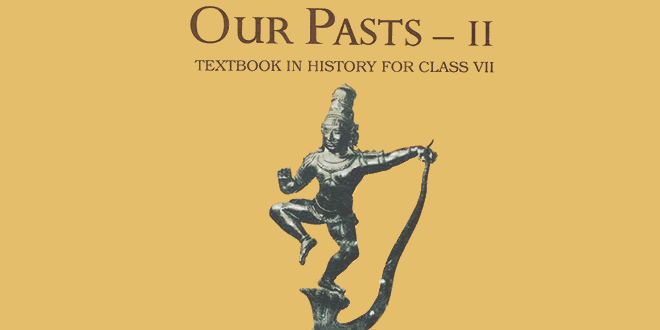Rulers and Buildings: NCERT 7th CBSE Social Studies Chapter 05
Rulers and Buildings – Question: How is the ‘trabeate’ principle of architecture different from the arcuate?
Answer:
- In trabeate principle of architecture roofs, doors and windows were made by placing a horizontal beam across two vertical columns.
- In arcuate principle of architecture the weight of the superstructure above the doors and windows was carried by arches.
Question: What is a shikhara?
Rulers and Buildings – Answer: A shikhara is the top most pointed portion of a temple.
Question: What is pietra dura?
Answer: Pietra dura refers to the colored, hard stones placed in depressions carved into marble or sandstone which create beautiful ornate patterns.
Question: What are the elements of a Mughal chahar bagh garden?
Answer: Mughal chahar bagh consists of four gardens. These gardens are placed within rectangular walled enclosures and divided into four quarters by artificial channels.
Question: How did a temple communicate the importance of a king?
Answer: The temples communicated the importance of a king in the following manner:
- Name of the temples and the king were almost similar
Examples:
King: Rajarajadeva
Temple: Rajarajeshvara
God: Rajarajeshvaram - The main Gods were identical in name with the kings.
- Lesser deities were gods and goddesses of the allies and subordinates of the ruler.
- Temple was the miniature model of the world ruled by the king and his allies.
Question: An inscription in Shah Johan’s diwan-i khas in Delhi stated, “If there is Paradise on Earth it is here, it is here, it is here”. How was this image created?
Answer: Shah Jahan’s diwan-i khas was designed in such a way that it fused together in a grand harmonious synthesis. It was carefully planned. It was placed within a large courtyard. Behind the emperor’s throne there were a series of pietra-dura inlays. It depicted the legendary god Orpheus playing the lute. The diwan-e khas was aimed to communicate that the king’s justice would treat the high and the low as equals, creating a world where all could live together in harmony. The diwan-i khas reflected the image of a paradise in itself.
Question: How did the Mughal court suggest that everyone – the rich and the poor, the powerful and the weak – received justice equally from the emperor?
Answer: The diwan-i khas of the Mughal court suggested that justice was made for all in an equal way. The construction of Shah Jahan’s audience hall was designed to communicate that the king’s justice was equal for the high and the low. Its aim was to create a world where all could live together in harmony. There was no difference between the rich and poor in the emperor’s court.
Question: What role did the Yamuna play in the layout of the new Mughal city at Shahjahanabad?
Answer: The river Yamuna had a very significant role in the layout of the new Mughal city at Shahjahanabad. Shah Jahan preferred the river-front garden in the layout of the Taj Mahal. He developed the same architectural form as a means to control the access that the nobles had to the river. In the new city of Shahjahanabad the imperial palace also commanded the river-front. Only the most favored nobles were given access to the river. Other than those had to construct their homes in the city away from the river Yamuna. It expanded the layout of the city.
Question: The rich and powerful construct large houses today. In what ways were the constructions of kings and their courtiers different in the past?
Answer: The rich and powerful construct large houses today. But these houses are not the same as those of the kings and their courtiers in the past. The houses of the kings and their courtiers were big structures with big courtyard, thick walls, domed-roofs, huge pillars, big gardens and well-decorated halls. But today houses have no courtyards nor gardens nor thick walls nor domed-roofs. In many ways these are inferior to those of the kings and their courtiers houses.

Question: Look at Figure 4 – How could that building be constructed faster today?
Answer: Such buildings were usually constructed as a matter of pride in old days. It was very difficult to construct them but they were made possible with the help of skilled masons and laborers. Such buildings took a very long time and a number of laborers to be constructed. But now as technologies have advanced, we have many facilities, equipment, tools which can construct huge buildings very easily and in less time.
Question: Find out whether there is a statue of or a memorial to a great person in your village or town. Why was it placed there? What purpose does it serve?
Answer: There is a very busy chowk in my village. We find there a statue of Subhash Chandra Bose and hence this chowk is known as Subhash Chowk. Subhash Chandra Bose was such a great person that he dared to challenge the British empire by forming his own army. He is now no more but his statue is there to inspire us. Its purpose is to encourage the youth to do something different and challenging.
Question: Visit and describe any park or garden in your neighborhood. In what ways is it similar to or different from the gardens of the Mughals?
Answer:The gardens of Mughals gardens were spread over a very large area. There were a large variety of flowers. They were well-decorated and protected. But the garden in my neighborhood is not so large. Everyone has easy access to this garden. So the flowers are not safe. Thus, we don’t find any similarity.
Question: Why was limestone cement used in construction of large structures?
Answer: Limestone cement was very high-quality cement, which, when mixed with stonechips hardened into concrete. This made construction of large structures easier and faster.
Rulers and Buildings – Question: How did the Persian court chronicles describe the Sultan?
Rulers and Buildings – Answer: Persian court chronicles described the Sultan as the ‘Shadow of God’.
Question: Name the ruler who won universal respect for constructing a large reservoir just outside Delhi-i kuhna?
Answer: Sultan Iltutmish
Question: What are the special features of Humayun’s tomb?
Answer:
- It has a central towering dome
- It has a tall gateway (pishtaq)
Question: What was maha mandapa?
Answer: It was the main hall in the temple where dances were performed.
Question: Name the temple built by king Rajarajadeva.
Answer: Rajarajeshvara temple
Question: When was the tomb of Humayun built?
Answer: It was built between 1562 and 1571.
Question: Who constructed the Kandariya Mahadeva temple?
Answer: King Dhangadeva of the Chandela dynasty constructed the Kandariya Mahadeva temple.
Question: Where was Shah Jahan’s capital in the early years of his reign?
Answer: It was at Agra
Question: What is the special feature of Fatehpur Sikri, Akbar’s capital?
Answer: Many of the buildings show the influence of the architectural styles of Gujarat and Malwa.
Question: Name the king who invaded Sri Lanka? Whom did he defeat?
Answer: King Shrimara Shrivallabha. He defeated the king, Sena I.
Question: What were havellis?
Answer: They were large mansions of the merchants.
Question: How did kings win the praise of their subjects?
Answer: They won the praise of their subjects by buildings structures meant for public activity such as temples, mosques, tanks, wells, caravanserais and bazaars.
Question: What type of structures were built by kings and their officers between the eighth and the eighteenth centuries?
Answer: During this period kings and their officers built two kinds of structur
- Forts, palaces, garden residences and tombs
- Structures meant for public activity including temples, mosques, tanks, wells, caravanserais and bazaars.
Question: Write a short note on the Kandariya Mahadeva temple.
Answer: The Kandariya Mahadeva temple dedicated to Shiva was constructed in 999 by the king Dhangadeva of the Chandela dynasty. The temple had an ornamented gateway that led to an entrance. It had a main hall known as mahamandapa where dances were performed. The image of the chief deity was kept in the main Shrine known as garbhagriha. This was the place for ritual worship where only the king and his kith and kin gathered.
Question: Throw light on how the construction of the Rqjarqjeshvara temple was a very difficult task.
Answer: The Raj araj eshvara temple was built in the early 11th century. It had the tallest shikhara amongst temples of its time. Its construction was a very difficult task. There were no cranes in those days. The 90 tonne stone for the top of the shikhara was too heavy to lift manually. Hence, the architects built an inclined path to the top of the temple, placed the boulder on rollers and rolled it all the way to the top. The path started more than 4 km away so that it would not be too steep. This was dismantled after the temple was built.
Question: In what ways do you think the policies of Rajendra I and Mahmud of Ghazni were a product of their time? How were the actions of the two rulers different?
Rulers and Buildings – Answer: King Rajendra I looted the temples of the defeated rulers and seized prized statues from them. He these statues in decoration of the Shiva temple, that he built in his capital in the early 11th century.
Sultan Mahmud of Ghazni was a contemporary of Rajendra I. He destroyed and looted the temples of defeated kings in order to win credit as a great hero of Islam.Thus, King Rajendra I constructed temple while Mahmud of Ghazni destroyed it. In this way, their actions were very much different.
Question: Write a brief note on the chahar bagh built by the Mughal rulers.
Answer: The Mughal emperors were very much interested in literature, art and architecture. Babur, in his autobiography, described his interest in planning and laying out formal gardens, placed within rectangular walled enclosures and divided into four quarters by artificial channels. These gardens were called chahar bagh, four gardens, because of their symmetrical division into quarters. Beginning with Akbar, some of the most beautiful chahar baghs were constructed by Jahangir and Shah Jahan in Kashmir, Agra and Delhi.
Question: When was Humayun’s tomb built? What are its special features?
Answer: Humayun’s tomb was, built between 1562 and 1571. Its main features are:
- The central towering dome and the tall gateway known as pishtaq became important aspects of Mughal architecture. This tomb architecture was first visible in Humayun’s tomb.
- The tomb was placed in the centre of a huge formal chahar bagh and built in the tradition known as ‘eight paradises’ or hasht bihisht—a central hall surrounded by eight rooms.
- The building was constructed with red sandstone, edge with white marble.
Rulers and Buildings – Question: Give an account of Shah Jahan’s audience halls.
Answer: Shah Jahan’s audience halls were specially constructed to resemble a mosque.
The pedestal on which his throne was placed was frequently described as the qibla, the direction faced by Muslims at prayer, since everybody faced that direction when court was in session. The idea of the king as a representative of God on earth was suggested by these architectural features.
The construction of Shah Jahan’s audience hall aimed to communicate that the king’s justice would treat the high and the low as equals creating a world where all could live together in harmony.
Question: Who were involved in the building of the Qutb Minar?
Answer: The Qutb Minar is five storeys high. The first floor was constructed by Qutbuddin Aybak and the rest by Iltutmish around 1229. Over the years it was damaged by lightning and earthquakes and repaired by Alauddin Khalji, Muhammad Tughluq, Firuz Shah Tughluq and Ibrahim Lodi.
Question: How can you say that Mughal rulers adapted regional architectural styles in the construction of their buildings? Explain with examples.
Answer: Mughal rulers were skilled in adapting regional architectural styles in the construction of their buildings. For example:
In Bengal, the local rulers had developed a roof that was designed to resemble a thatched hut. The Mughals liked this ‘Bangla dome’ and used it their architecture.
In Akbar’s capital at Fatehpur Sikri many of the buildings show the influence of the architectural styles of Gujarat and Malwa.
Question: Describe how Shah Jahan adapted the riverfront garden in the layout of the Taj Mahal.
Answer: The Taj Mahal is the grandest architectural accomplishment of Shah Jahan’s reign. He adapted the river-front garden in the its layout. Here, the white marble mausoleum was placed on a terrace by the edge of the river and the garden was to its south. Shah Jahan developed this architectural form as a means to control the access that nobles had to the river.
Question: What is the main feature of Shah Jahan’s new city of Shahjahanabad?
Answer: Shah Jahan constructed a new city namely Shahjahanabad in Delhi. In this city, the imperial palace commanded the river-front. Only specially favored nobles like his oldest son Dara Shukoh were given access to the river. All others had to construct their homes in the city away from the River Yamuna.
Rulers and Buildings – Question: Compare the reasons why temples were built and destroyed?
Answer: Kings built temples to show their devotion to God and their power and wealth. King Rajarajeshvara built Rajarajeshvara temple for the worship of his god, Rajarajeshvaram. Here, the names of the king and the god appear to be similar. The king took the god’s name because it was auspicious and he wanted to appear like a god. The largest temples were usually built by kings while the other, lesser deities in the temples were gods and goddesses of the allies and subordinates of the ruler.
The temple was a miniature model of the world ruled by the king and his allies. As they worshipped the deities together in the royal temples, it seemed as if they brought the just rule of the gods on earth. Kings built temples but when they attacked one another’s kingdoms they often targeted these buildings.
In the early 9th century when the Pandyan King Shrimara Shrivallabha invaded Sri Lanka and defeated the King Sena I he seized all the valuables such as the statue of the Buddha made entirely of gold and other golden images from various monasteries. King Sena II took revenge of this. He invaded Madurai, the capital of the Pandyas in order to restore the gold statue of the Buddha.
In the same way when in the early 11th century the Chola King Rajendra I built a Shiva temple in his capital. He filled it with prized statues seized from defeated rulers. Sultan Mahmud of Ghazni not only seized the valuables from the temples but . also destroyed them. He did it in order to win credit as a great hero of Islam Thus, rulers displayed their political might and military success by attacking and looting the places of worship of defeated rulers.
 Class Notes NCERT Solutions for CBSE Students
Class Notes NCERT Solutions for CBSE Students



